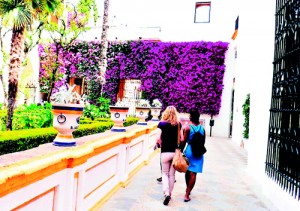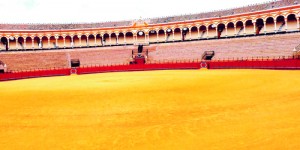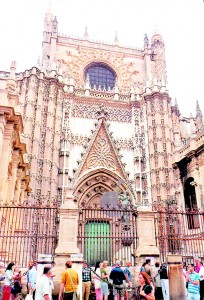From hot debate on bullfighting to a cooling Sangria
A two hour train ride from Madrid on the Renfe took us past low mountains, farm animals, olive fields to this city with its flowering bougainvillea, date palms and Spanish and Moorish architecture. Our small hotel “ Palacio Alcazar“ with a balcony overlooking the street was exquisite with painted doors and so well situated near the main square known as Plaza Virgen de los Reyes and the

Gardens of the Real Alcazar Palace
Cathedral. Horse drawn carriages for the tourists, numerous cafes, Hare Rama followers and tourists milling around greeted visitors.
Our first choice was to see the Gothic Seville Cathedral and La Giralda, the Moorish tower that was originally the site of a mosque between 1184 and 1198. The only legacy of the Moorish period, that remains is the bell tower and it’s quite a hike (if one is fit enough to climb over 300 steps, to take in the view of the city, which I did). The work on the Cathedral was commenced in the 14th century and took over a century to complete. Christopher Columbus’ body rests here borne by four carriers. There are numerous altars and private chapels but I would rate the Cathedral I saw in Toledo as outstanding. A little girl dressed in a traditional Spanish flamenco costume caught my eye and I whipped out my camera and the senorita immediately responded with a dance pose replete with fan.
The Seville bull ring is Baroque in style and is the second largest in Spain. We visited to tour and not experience a fight, which I refused to witness. Bull fighting is now banned in Barcelona and the Canary Islands. Seventy noble families own the ring and the profits are divided among the owners. The special sand in the ring is brought from the mountains. Prices of the 14,000 seating differ according to the position – shade or sun. The Royal box is located on one side and the Chief of Police on the opposite side. The season is from April to October and in April a bull fight is held every week.

The Broque-style bull ring in Seville
The fighting bulls are reared to be eventually sold when they are four years old and are brought to the ring the day before. The Matador enters the bull ring after a flag is waved from the main box for the fight to commence. He is present for five minutes with a pink cape to gauge the temperament of the bull and thereafter is followed by a Picador on a horse with a lancer and his helpers for ten minutes where he darts the bull in sensitive places. Thereafter the Matador enters again with a red cape and after intimidating the bull kills it straight through the heart. The whole spectacle is supposed to conclude in 25 minutes if the Matador is skilled.

The Gothic-style Cathedral
Most of the visitors on the tour were appalled by the sport and we entered into a heated debate with the guide with regard to the cruelty to the animal; the bull did not have a chance against the Matador or Picador. Two of the best Matadors ever met untimely deaths one gored by a bull and the other committing suicide when he retired. I was not surprised. A first-class Matador is paid Euros 150,000/- and their costumes which we saw in the museum are elaborate costing up to E 7,000/-. There are fifty Matadors presently, ten of whom are considered masters in their sport. There is a private chapel for the Matadors to pray for success prior to entering the ring. If the bull has been exceptionally brave, a flag is waved and the bull saved which is rare. The horses are blindfolded as there was an instance where twenty horses were gored by the bulls on a single day. Formerly, the meat of the bull was given to the poor. Music is played by a band if the Matador is good.
Real Alcazar just next to our hotel was built in 1364 by Pedro I. Within two years craftsmen from Granada and Toledo built this jewel of Mudejar patios and halls. Future kings left their own mark. The gardens with terraces, fountains and water channel, potted plants in porcelain pots are beautifully laid out creating an oasis for the owner and visitor. The upper floor is inhabited by the Royal family. One can wander through the Patio de Las Doncellas with its plaster work, the Charles V rooms with huge tapestries. Porcelain tiles of yellows, oranges mixed with blue and green give added colour to the alabaster and light limestone buildings. To me it was a mini Alhambra, as exquisite in its detail and a venue not to be missed.
After a fascinating day, we sat in a wayside cafe cooling off with Sangria and enjoying the seafood platters followed with churrios dipped in hot chocolate.


